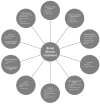Pathophysiological Mechanisms of Renal Fibrosis: A Review of Animal Models and Therapeutic Strategies
- PMID: 28064215
- PMCID: PMC5354133
- DOI: 10.21873/invivo.11019
Pathophysiological Mechanisms of Renal Fibrosis: A Review of Animal Models and Therapeutic Strategies
Abstract
Chronic kidney disease (CKD) is a long-term condition in which the kidneys do not work correctly. It has a high prevalence and represents a serious hazard to human health and estimated to affects hundreds of millions of people. Diabetes and hypertension are the two principal causes of CKD. The progression of CKD is characterized by the loss of renal cells and their replacement by extracellular matrix (ECM), independently of the associated disease. Thus, one of the consequences of CKD is glomerulosclerosis and tubulointerstitial fibrosis caused by an imbalance between excessive synthesis and reduced breakdown of the ECM. There are many molecules and cells that are associated with progression of renal fibrosis e.g. angiotensin II (Ang II). Therefore, in order to understand the biopathology of renal fibrosis and for the evaluation of new treatments, the use of animal models is crucial such as: surgical, chemical and physical models, spontaneous models, genetic models and in vitro models. However, there are currently no effective treatments for preventing the progression of renal fibrosis. Therefore it is essential to improve our knowledge of the cellular and molecular mechanisms of the progress of renal fibrosis in order to achieve a reversion/elimination of renal fibrosis.
Keywords: Rats; disease; kidneys; mice; renal function; review.
Copyright© 2017, International Institute of Anticancer Research (Dr. George J. Delinasios), All rights reserved.
Figures


Similar articles
-
Endothelial Dysfunction in Renal Interstitial Fibrosis.Nephron. 2016;134(3):167-171. doi: 10.1159/000447607. Epub 2016 Aug 30. Nephron. 2016. PMID: 27576317 Free PMC article. Review.
-
Contribution of genetics and epigenetics to progression of kidney fibrosis.Nephrol Dial Transplant. 2014 Sep;29 Suppl 4:iv72-9. doi: 10.1093/ndt/gft025. Epub 2013 Aug 23. Nephrol Dial Transplant. 2014. PMID: 23975750 Review.
-
Metformin Prevents Renal Fibrosis in Mice with Unilateral Ureteral Obstruction and Inhibits Ang II-Induced ECM Production in Renal Fibroblasts.Int J Mol Sci. 2016 Jan 22;17(2):146. doi: 10.3390/ijms17020146. Int J Mol Sci. 2016. PMID: 26805826 Free PMC article.
-
Ureic clearance granule, alleviates renal dysfunction and tubulointerstitial fibrosis by promoting extracellular matrix degradation in renal failure rats, compared with enalapril.J Ethnopharmacol. 2014 Sep 29;155(3):1541-52. doi: 10.1016/j.jep.2014.07.048. Epub 2014 Aug 1. J Ethnopharmacol. 2014. PMID: 25087615
-
[Molecular mechanisms of nephro-protective action of enalapril in experimental chronic renal failure].Ann Acad Med Stetin. 1999;Suppl 52:1-93. Ann Acad Med Stetin. 1999. PMID: 10589103 Review. Polish.
Cited by
-
Asymmetric dimethylarginine (ADMA) accelerates renal cell fibrosis under high glucose condition through NOX4/ROS/ERK signaling pathway.Sci Rep. 2020 Sep 29;10(1):16005. doi: 10.1038/s41598-020-72943-2. Sci Rep. 2020. PMID: 32994511 Free PMC article.
-
Update on the Mechanisms of Tubular Cell Injury in Diabetic Kidney Disease.Front Med (Lausanne). 2021 Mar 30;8:661076. doi: 10.3389/fmed.2021.661076. eCollection 2021. Front Med (Lausanne). 2021. PMID: 33859992 Free PMC article. Review.
-
STAT1-p53-p21axis-dependent stress-induced progression of chronic nephrosis in adriamycin-induced mouse model.Ann Transl Med. 2020 Aug;8(16):1002. doi: 10.21037/atm-20-5167. Ann Transl Med. 2020. PMID: 32953802 Free PMC article.
-
Osthole Ameliorates Renal Fibrosis in Mice by Suppressing Fibroblast Activation and Epithelial-Mesenchymal Transition.Front Physiol. 2018 Nov 21;9:1650. doi: 10.3389/fphys.2018.01650. eCollection 2018. Front Physiol. 2018. PMID: 30524310 Free PMC article.
-
A blockade of PI3Kγ signaling effectively mitigates angiotensin II-induced renal injury and fibrosis in a mouse model.Sci Rep. 2018 Jul 20;8(1):10988. doi: 10.1038/s41598-018-29417-3. Sci Rep. 2018. PMID: 30030497 Free PMC article.
References
-
- Lopez-Novoa JM, Martinez-Salgado C, Rodriguez-Pena AB, Lopez-Hernandez FJ. Common pathophysiological mechanisms of chronic kidney disease: Therapeutic perspectives. Pharmacol Ther. 2010;128(1):61–81. - PubMed
-
- McCarty MF. Adjuvant strategies for prevention of glomerulosclerosis. Med Hypotheses. 2006;67(6):1277–1296. - PubMed
-
- Chia TY, Sattar MA, Abdullah MH, Ahmad FUD, Ibraheem ZO, Li KJ, Pei YP, Rathore HA, Singh GKC, Abdullah NA, Johns EJ. Cyclosporine A-induced nephrotoxic Sprague-Dawley rats are more susceptable to altered vascular function and haemodynamics. Int J Pharm Pharm Sci. 2012;4(2):431–439.
-
- Zhao J, Wang H, Cao AL, Jiang MQ, Chen X, Peng W. Renal tubulointerstitial fibrosis: A review in animal models. J Integr Nephrol Androl. 2015;2(3):75–80.
-
- Fogo AB. Progression and potential regression of glomerulosclerosis. Kidney Int. 2001;59(2):804–819. - PubMed
Publication types
MeSH terms
LinkOut - more resources
Full Text Sources
Other Literature Sources
Medical
Miscellaneous
